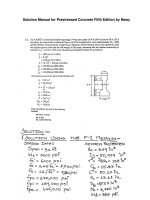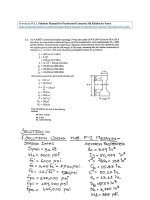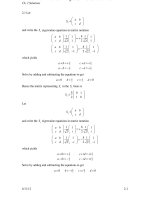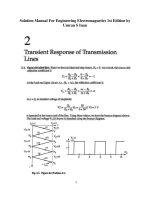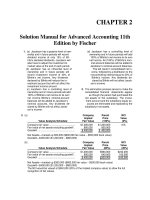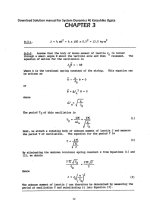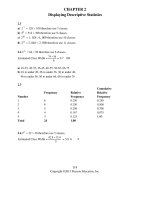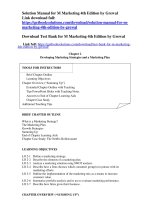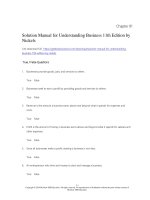Solution manual for financial management for public health and not for profit organizations 4th edition by finkler calabrese purtell and smith
Bạn đang xem bản rút gọn của tài liệu. Xem và tải ngay bản đầy đủ của tài liệu tại đây (168.17 KB, 4 trang )
Chapter 3: Additional Budgeting Concepts
QUESTIONS FOR DISCUSSION
3-1. Yes. If taxes are deemed to be unacceptably high, people may circumvent them,
even if it means moving to another jurisdiction. Unlimited spending can lead to
deficits that could bankrupt the government, or at a minimum create rising interest
rates and costs that might be more than can be sustained over time.
3-2. A line-item budget shows the costs of the organization broken down by spending for
each traditional line-item of expenditure, such as salaries, supplies, rent,
depreciation, and interest. Responsibility center budgets show the amount budgeted
to be spent by each responsibility center. A responsibility center is a unit or
department that is under the direction of a manager who is responsible for its
financial performance. A program budget shows the amount of spending for each
of the major programs of the organization. Typically responsibility and program
budgets are further subdivided to show line-item expenses.
3-3. The critical issue is in the type of information generated by each. A line item budget
will tell Mary how much was spent on art rental, shipping, and salaries for all
programs. Mary has to decide which exhibits to eliminate, so she must know all of
the costs for each program, regardless of whether they relate to shipping, rent of
art, or insurance. Then she can judge which programs to eliminate. She will not
necessarily eliminate the most expensive. The cost of each program will have to be
weighed against its benefits.
3-4. A top-down budget is one that is prepared by top management. The budgeted
amount is given to responsibility center managers, who are expected to achieve the
budgeted result. However, it is very difficult for top managers to be aware of all of
the likely factors affecting spending in each responsibility unit. An alternative
approach is bottom-up, in which responsibility unit managers propose budgets for
their unit and provide justification for the requested spending.
A bottom-up approach makes better use of the expertise of employees
throughout the organization, is more likely to result in employees who want to
achieve the budget, and is more likely to be achieved. However, it requires top
management willing to accept some degree of
decentralization. In very autocratic, centralized organizations where top management
desires retention of high levels of control, a top-down budget is more likely to be
employed.
3-5. False.
3-6. Zero-based budgeting could be very effective here. Rather than simply adding a certain percent to
all departments, or even evaluating incremental requests from all departments, ZBB would result
in an analysis of the future needs for each department in light of the changing conditions. Rather
than an incremental approach, the city needs a method that can substantially reallocate resources
among city departments, either upward or downward for each department.
3-7. Program services and supporting services. It is nice for a not-for-profit organization to be able to
track the portion of spending that is going directly toward providing services, and therefore
accomplishing its mission.
3-8. Mandates are requirements that certain spending take place. For example, the state could mandate
that every local government spend at least $500,000 per year to provide public library services.
Entitlements are benefits that must be given to any individuals who meet eligibility criteria
specified in the law creating the entitlement. For example, Medicare applies to everyone over a
certain age who applies. If the number of eligible applicants increases, the government must
provide Medicare benefits to those individuals, even if it causes government spending levels to
be higher than desired.
3-9. Performance budgeting is an approach designed to improve the budget process by focusing more
on what we hope to accomplish than simply on inputs used. The method calls upon the manager
and organization to define goals, plan the amount of resources needed to accomplish those goals,
and then assess how well the goals have been achieved. The method is particularly useful when
it is possible to apparently do the same amount of work with different budgeted amounts of
resources (e.g., maintain ten parks), yet the underlying quality of worked performed does not
remain constant.
The first step is to clearly define objectives, referred to as performance areas. Next, one
must identify the operating budget. Then the percent of operating budget resources that will be
devoted to each objective must be determined. The operating budget resources can then be
allocated to the performance areas. Measures of performance for each objective or performance
area must be established. Then a performance budget can be developed.
3-10. False.
3-11. This is a technique that argues that all costs in the budget must be justified each year, not just
budget increases from year to year. The method also focuses on the evaluation of alternatives
and their costs and benefits.
3-12. C.
3-13. A flexible budget is an operating budget for varying workload levels. It gives managers an
understanding of what is likely to happen to revenues, expenses, and profits (surpluses or
deficits) if the volume of services provided varies from the expected level.
3-14. No. There may be trend or seasonality. If so, the average will obfuscate such variability.
3-15. The closer a forecast line is to historical data points, the closer it is likely to be to future results.
By fitting historical data to a curved line rather than a straight line, they are likely to be closer
to
that line. Projecting that curved line into the future is therefore likely to produce a more
accurate prediction of the actual future results.
3-16. False. Computers fail to take into account what people know. Managers may have information
about why the futue is unlikely to be a reflection of the past. Such managerial information
should be used to modify computer-generated predictions.
3-17. There are two common techniques designed specifically to help improve the accuracy of
estimates when no specific historical information is available. These are the Delphi and
nominal group techniques. In both approaches, a team or panel must be selected that consists
of individuals who are likely to have reasoned insights with respect to the item being forecast.
The nominal group technique is one in which the individuals are brought together in a
structured meeting. Each member writes down a forecast. Then all of the written forecasts are
presented to the group by a group leader without discussion. Once all the forecasts have been
revealed, the reasoning behind each one is discussed. After the discussions, each member again
makes a forecast in writing. Through a repetitive process, a group decision is eventually made.
In the Delphi approach, the group never meets. All forecasts are presented in writing to a group
leader, who provides summaries to all group members. After several rounds a decision is made
based on the collective responses. The weakness of the Delphi method is that it takes more
time and is more cumbersome than the nominal group method. Nevertheless, Delphi decisions
are based more on logic than on personality or position.
3-18. These statements separate activities into their major functions of providing
services, administration, and fund-raising.
PROBLEMS
The exhibits below are embedded Excel objects. Double-clicking on them will open an
Excel spreadsheet.
3-19 1. a. Zero-Based
2. f. Flexible
3-20. SALARIES, BENEFITS, SUPPLIES, RENT, INTEREST, ETC.
3-21.
1.
2.
3.
4.
f. FLEXIBLE
e. CAPITAL BUDGETS
a. ZERO-BASED
d. ACCRUAL
3-22. Performance budgets focus on _____outcomes or results, what they were trying to achieve,
goals and objectives, mission or other similar answers_____ rather than solely on outputs.
3-23
MUTT RESCUE OPERATING
BUDGET
Revenue
Adoption Fee
Additional Contributions
Fund Raising
Total Revenue
Flexible
Budget
Base Budget
$ 180,000 $ 189,000
21,000
22,050
40,000
40,000
$ 241,000 $ 251,050
# dogs * fee
# dogs * % placed * % extra donation
Fixed
Expenses
Salaries
Benefits
Base Vet expenses
Spay/Neuter & Transport
Food
Depreciation
Total Expenses
$ 95,000 $ 95,000
23,750
23,750
43,200
45,360
48,000
50,400
10,560
11,088
20,000
20,000
$ 240,510 $ 245,598
Sum of salaries - all fixed
Benefit % * salaries
# dogs * visits * fee
# dogs * spay fee & transport cost
# dogs * days * cost of food per day
Cost of kennel & equipment/life - fixed
Profit/(Loss)
$
490 $
5,452
3-24
Stratton County Community
College Band
Revenue
Tuition
Community Musicians
Concert Revenues
Total Revenue
$ 29,750
2,000
4,500
$ 36,250
35 students * $500 * 2 semesters
20 community musicians * $50 * 2 semseters
4 concerts * 200 people * $3.00
Expenses
Salaries
Instrument Rental
Instrument Depreciation
Music
Rehearsal Space Rental
Variable Concert Costs
Fixed Concert Costs
$ 15,000
3,300
2,800
4,500
7,500
1,350
2,550
1 Graduate Assistant * $15,000
10 instruments * $90 * 2 semesters
(Tuba $4000 + Bari $2,500 + Percussion $7,500)/5 years
30 arrangements * $150 each
15 nights per semester $250 per night * 2 semesters
$.75 per person * 200 people * 4 concerts
($100 cleaning + $50 student labor + $200 promotion
+ $75 insurance) * 4 concerts
Total Expenses
$ 37,000
Surplus/(Deficit)
$ (750)
3-25. (Flexible Budget) The Zoo expects the following number of visitors per month:.
Visitor Type
Adult
Child
School child
Families
Monthly
Number of
Admissions
Tickets
800
950
1,000
300
Price per
Admission
Admission
Total
Revenue Admissions
$6,400
4,750
3,000
6,000
800
950
1,000
1,200
$20,150
3,950
8
5
3
20
Total
Flexible 10%
Base Budget
Flexible +
10%
Revenues
County Gra nt
Admissions
Total Revenues
$ 7,000
18,135
$ 2 5,135
$
7,000
20,150
$ 2 7,150
$
Expenses
Administrat ion
Staff
Training Costs
Maintenance
Total Expenses
$ 12,000
10,000
1,185
3,555
$ 26,740
$ 12,000
10,000
1,317
3,950
$
27,267
$ 12,000
10,000
1,448
4,345
$ 27,793
$
$
Profit/(Loss)
$ (1,605)
(117)
7,000
22,165
$ 2 9,16 5
1,372
3-26. (Flexible Budget)
(Flexible Budget)
Inputs
$
Price
6.00
18,000
$
6.50
16,000
6.00
18,000
$ 108,000
$
6.50
16,000
04,000
$ 32,000
80,000
$ 32,000
72,000
$ 32,000
64,000
($2,000)
$4,000
$8,000
Volume
5.50
20,000
$
$ 4.00
$ 32,000
Variable Cost
Fixed Cost
Price
Volume
Revenue
$
5.50
20,000
$ 110,000
Less Fixed Cost
Less Variable Cost
Surplus/(Deficit)
$
$ 1
3-27. (Performance Budget)
Total
Arrests %
Traffic
Citations%
Inputs
Salary
Vehicle costs
Supplies
Volume
$ 3,000,000
$ 200,000
$ 300,000
7,000
Total
30%
25%
40%
1,000
Arrests
Emergency
Response
%
30%
30%
10%
4,000
Traffic
Citations
15%
5%
25%
2,000
Emergency
Response
Salary
Vehicle costs
Supplies
$ 3,000,000 $ 900,000 $ 900,000 $ 450,000
200,000
50,000
60,000
10,000
300,000
120,000
30,000
75,000
Total
$ 3,500,000
$ 1,070,000
$ 990,000
$ 535,000
Performance Budget
from above
$ 1,070,000 $ 990,000 $ 535,000
Budgeted Volume
1,000
4,000
2,000
Cost/unit
$
1,070 $
248 $
268
per arrest
per citation per response
Traffic citations serve to not only punish violators, but to protect society. The
possibility of being stopped for a citation possibly prevents people from speeding,
running red lights, etc. If the Village stopped issuing citations, it would make the co
3-28 (Line-Item Budget) Also see Excel file for more details.
Eger Township
Budget
For Year Ending March 31, 2014
Salaries
Fringe Benefits
Supplies
Telephone
Gas & Electric
Rent
Interest
Depreciation
3-29 Responsibility Budget)
$2,204,451.50
462,934.82
187,235.82
32,255.52
71,832.68
128,349.00
42,410.00
438,827.00
$ 3,568,296.34
Also see Excel file for more details.
Eger Township
Budget
For Year Ending March 31, 2014
Management
Public Works
Recreation
Public Safety
$1,766,645.43
670,216.04
312,217.63
819,217.24
$ 3,568,296.34
3-30 (Responsibility Budget Showing Line Items) See also Excel file.
Eger Township
Budget
For Year Ending March 31, 2014
Salaries
Fringe Benefits
Supplies
Rent
Gas & Electric
Telephone
Depreciation
Interest
Recreation
$ 107,071.00
22,484.91
39,603.00
0.00
8,865.34
4,414.38
129,779.00
0.00
$312,217.63
Public Safety
$ 461,203.50
96,852.74
38,095.00
0.00
7,780.00
9,510.00
205,776.00
0.00
$819,217.24
Public Works
$ 387,457.00
81,365.97
85,553.59
0.00
22,637.34
4,130.14
89,072.00
0.00
$670,216.04
Management
Total
$ 1,248,720.00
$2,204,451.50
262,231.20
462,934.82
23,984.23
187,235.82
128,349.00
128,349.00
32,550.00
71,832.68
14,201.00
32,255.52
14,200.00
438,827.00
42,410.00
42,410.00
$1,766,645.43 $3,568,296.34
Note: Generally salaries are shown near the top of the budget. Then fringe benefits, which are
directly related to salaries are shown next. Larger items would then be shown, followed by
smaller amounts. Interest and depreciation are often less control
3-31 (Functional Budget)
See also Excel file.
Eger Township
Budget
For Year Ending March 31, 2013
Support
Function
Program Functions
Park
Police
Fire
Garbage
Snow
Protection Protection
Collection
Removal
Salaries
$ 310,432 $ 150,772 $ 241,089 $
Fringe Benefits
65,191
31,662
50,629
Supplies: Office
7,957
4,426
1,832
Supplies: Parks
Supplies: Concerts
Supplies: Athletic
Supplies: Salt
Supplies: Blacktop
Supplies: Fire Truck
22,856
Supplies: Uniforms
2,856
Rent
Gas & Electric
3,890
3,890
2,385
Telephone
4,755
4,755
1,832
Depreciation Exp. 52,888
152,888
40,000
Interest
Total
$ 447,969 $ 371,249 $ 337,767 $
3-32
Road
Repair
Maintenance
Concerts
Athletics
Management
84,736 $ 61,632 $ 31,555 $ 14,315 $ 61,201 $ 1,248,720
17,795 12,943
6,627 3,006 12,852 262,231
832
3,163
427
624
3,890
23,984
4,278
- 2,941
- 27,443
36,748
- 42,979
128,349
18,236
2,016
524
262
8,079
32,550
1,273
1,025
617
619
3,178
14,201
20,128 28,944
8,293 2,744 118,742
14,200
42,410
179,747 $ 152,702 $ 52,321 $ 24,511 $ 235,386 $ 1,766,645
Total
$ 2,204,452
462,935
47,135
4,278
2,941
27,443
36,748
42,979
22,856
2,856
128,349
71,833
32,256
438,827
42,410
$ 3,568,296
(Line-Item, Responsibility, And Functional Budget Using Chart-Of-Account Numbers)
See also Excel Solution.
Part A.
State Budget
Department of Labor
For the Year Ending June 30, 2015
Revenues
Direct State Appropriations
Grants-in-Aid
$22,735,519
26,958,230
Total Revenues
$49,693,749
Part B.
State Budget
Department of Labor
For the Year Ending June 30, 2015
Revenues
Economic Planning and Development
Economic Assistance and Security
Manpower and Employment Services
Total Revenues
$15,972,206
24,651,316
$9,070,227
$49,693,749
